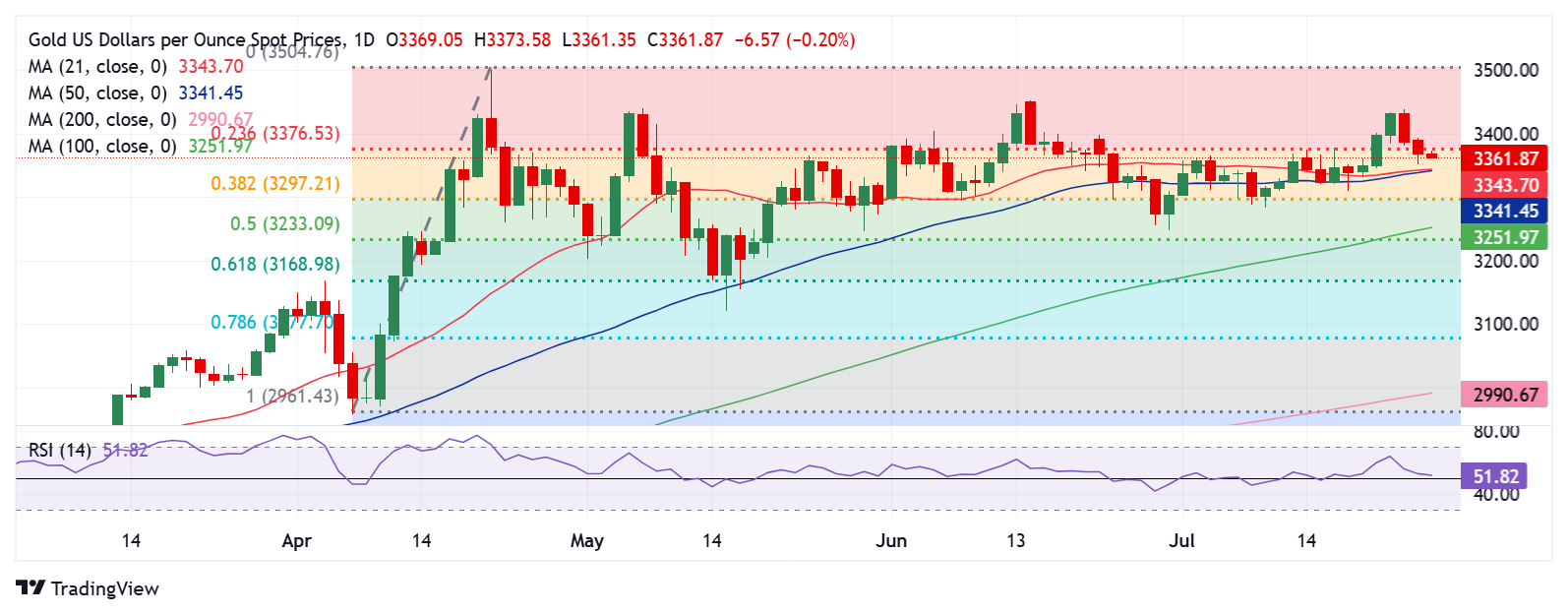
- Gold price has paused its two-day downtrend early Friday, eyeing a weekly gain.
- The US Dollar attempts a tepid bounce as markets turn cautious amid raging Thailand-Cambodia conflict.
- Gold price breached the key 23.6% Fibo support at $3,377 but downside appears capped amid a bullish RSI.
Gold price is licking its wounds below $3,400 early Friday, having bounced off the $3,350 psychological mark. Despite the recent pullback from five-week highs, Gold price remains on track to book a weekly gain.
Gold price eyes a profit-taking advance, as focus shifts to Fed
Markets have turned a bit in Friday’s Asian trading, assessing the gravity of the ongoing military conflict between Thailand and Cambodia.
Both Asian nations have requested the United Nations Security Council to call an emergency meeting on Friday, according to China’s CCTV News.
The neighbours are locked in a bitter spat over an area known as the Emerald Triangle, where the borders of both countries and Laos meet, and which is home to several ancient temples.
Investors remain worried that the clash between these two countries does not translate into a wider regional conflict.
Risk-off flows revive the haven demand for both the US Dollar (USD) and Gold price, fuelling a bounce in the former while capping the latter’s downside.
Additionally, markets remain wary ahead of next week’s crucial US Federal Reserve (Fed) and the Bank of Japan (BoJ) monetary policy decisions.
Hence, a short-covering recovery in Gold price cannot be ruled out as the USD heads for the biggest weekly drop on easing trade tensions.
US trade deals with Japan, Indonesia and Philippines, as well as, some progress on the US and European Union (EU) trade negotiations have helped ebb fears over a potential tariff war restarting as the August 1 deadline nears.
Besides, the mid-tier US Durable Goods Orders data could keep traders entertained heading into the weekend.
Gold price technical analysis: Daily chart

Gold price extended the downside on Thursday and settled below the 23.6% Fibonacci Retracement (Fibo) level of the April record rally at $3,377, then a powerful resistance-turned-support.
However, the 14-day Relative Strength Index (RSI) remains above the midline, currently near 52, keeping buyers hopeful.
They need to recapture the abovementioned Fibo level of $3,377 to regain the upper hand.
Acceptance above the $3,440 static resistance is critical for a sustained uptrend, targeting the June 16 high of $3,453 next.
If the selling bias intensifies again, Gold price could challenge the $3,340 area, which is the confluence of the 21-day SMA and the 50-day SMA.
The next support on sellers’ radars is the 38.2% Fibo level of the same rally at $3,297.
Gold FAQs
Gold has played a key role in human’s history as it has been widely used as a store of value and medium of exchange. Currently, apart from its shine and usage for jewelry, the precious metal is widely seen as a safe-haven asset, meaning that it is considered a good investment during turbulent times. Gold is also widely seen as a hedge against inflation and against depreciating currencies as it doesn’t rely on any specific issuer or government.
Central banks are the biggest Gold holders. In their aim to support their currencies in turbulent times, central banks tend to diversify their reserves and buy Gold to improve the perceived strength of the economy and the currency. High Gold reserves can be a source of trust for a country’s solvency. Central banks added 1,136 tonnes of Gold worth around $70 billion to their reserves in 2022, according to data from the World Gold Council. This is the highest yearly purchase since records began. Central banks from emerging economies such as China, India and Turkey are quickly increasing their Gold reserves.
Gold has an inverse correlation with the US Dollar and US Treasuries, which are both major reserve and safe-haven assets. When the Dollar depreciates, Gold tends to rise, enabling investors and central banks to diversify their assets in turbulent times. Gold is also inversely correlated with risk assets. A rally in the stock market tends to weaken Gold price, while sell-offs in riskier markets tend to favor the precious metal.
The price can move due to a wide range of factors. Geopolitical instability or fears of a deep recession can quickly make Gold price escalate due to its safe-haven status. As a yield-less asset, Gold tends to rise with lower interest rates, while higher cost of money usually weighs down on the yellow metal. Still, most moves depend on how the US Dollar (USD) behaves as the asset is priced in dollars (XAU/USD). A strong Dollar tends to keep the price of Gold controlled, whereas a weaker Dollar is likely to push Gold prices up.
Information on these pages contains forward-looking statements that involve risks and uncertainties. Markets and instruments profiled on this page are for informational purposes only and should not in any way come across as a recommendation to buy or sell in these assets. You should do your own thorough research before making any investment decisions. FXStreet does not in any way guarantee that this information is free from mistakes, errors, or material misstatements. It also does not guarantee that this information is of a timely nature. Investing in Open Markets involves a great deal of risk, including the loss of all or a portion of your investment, as well as emotional distress. All risks, losses and costs associated with investing, including total loss of principal, are your responsibility. The views and opinions expressed in this article are those of the authors and do not necessarily reflect the official policy or position of FXStreet nor its advertisers. The author will not be held responsible for information that is found at the end of links posted on this page.
If not otherwise explicitly mentioned in the body of the article, at the time of writing, the author has no position in any stock mentioned in this article and no business relationship with any company mentioned. The author has not received compensation for writing this article, other than from FXStreet.
FXStreet and the author do not provide personalized recommendations. The author makes no representations as to the accuracy, completeness, or suitability of this information. FXStreet and the author will not be liable for any errors, omissions or any losses, injuries or damages arising from this information and its display or use. Errors and omissions excepted.
The author and FXStreet are not registered investment advisors and nothing in this article is intended to be investment advice.







